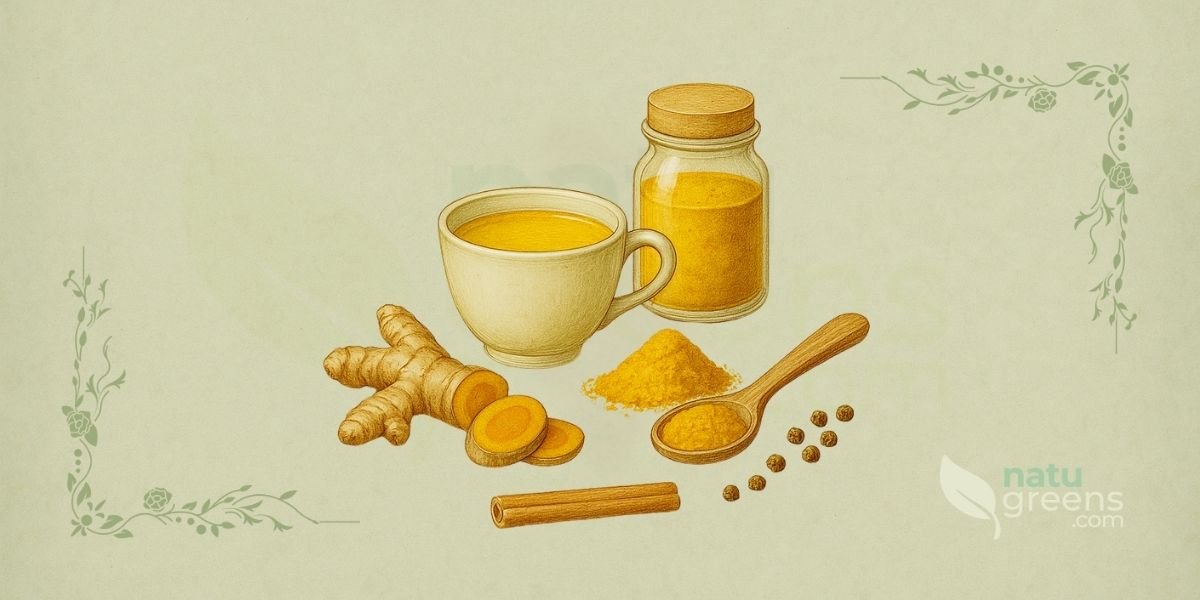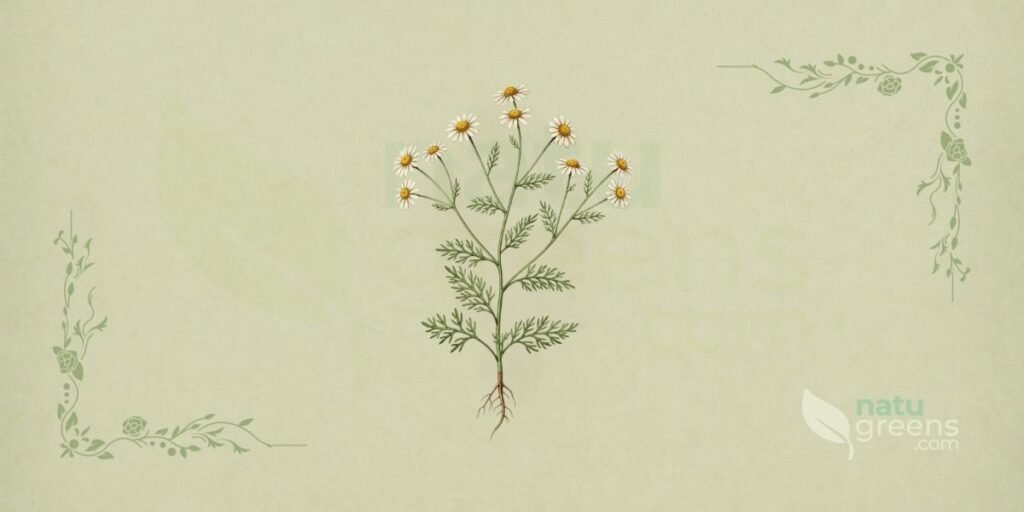Curcuma longa L. / Turmeric, known as turmeric, is an herbaceous plant from the Zingiberaceae family, native to Southeast Asia. Used for over 4,000 years in Ayurvedic and Chinese medicine, it is distinguished by its orange rhizome, rich in curcumin, a polyphenol with potent anti-inflammatory and antioxidant properties.
Traditionally, it has been employed in treating digestive disorders, inflammation, and liver conditions. Modern science has validated many of these uses, consolidating turmeric as one of the most researched and valued medicinal plants globally, present in herbal teas, culinary dishes, and pharmaceuticals.
Popular and International Names of Curcuma longa
- English: turmeric, Indian saffron, yellow ginger, curcuma.
- French: curcuma, safran des Indes, turmeric.
- German: Kurkuma, Gelbwurz, Indischer Safran, Gelber Ingwer.
- Italian: curcuma, zafferano delle Indie, turmerico.
- Portuguese: cúrcuma, açafrão-da-terra, açafrão-da-índia (PT); açafrão-da-terra, cúrcuma, gengibre-amarelo (BR).
- Spanish: cúrcuma, azafrán de la India, turmérico, jengibre amarillo.
Botanical Synonyms of Curcuma longa
The nomenclature of Curcuma longa has historical synonyms. Curcuma domestica Valeton was a common name in older literature, and Amomum curcuma Jacq. was used before the genus reclassification. Other synonyms include Curcuma brog Valeton and Stissera curcuma Raeusch.
Currently, Curcuma longa L. is the accepted and validated name by the international scientific community, as recorded in databases such as The Plant List and World Flora Online.
Botanical Family: Zingiberaceae
The Zingiberaceae family, or ginger family, includes about 50 genera and over 1,600 species of tropical plants. It is characterized by aromatic rhizomes, large leaves, and showy flowers. Besides turmeric, it includes ginger (Zingiber officinale) and cardamom (Elettaria cardamomum).
Zingiberaceae are valued for their culinary properties and bioactive compounds with therapeutic applications, standing out in traditional Asian medicine.

Botanical illustration of Curcuma longa L. (turmeric, açafrão-da-terra, cúrcuma), perennial herbaceous plant of the Zingiberaceae family described by Carl Linnaeus in 1753, native to South Asia, showing complete plant with large oblong-lanceolate green leaves, thick rhizomatous root system with characteristic bright orange-yellow interior in cross-section, and spike of pale yellow tubular flowers, in 19th-century botanical encyclopedia style on aged herbarium paper background.
Parts Used of Curcuma longa
- Fresh rhizome
- Dried and powdered rhizome
Ethnobotanical and Traditional Uses of Curcuma longa
- Cardiovascular prevention
- Digestive disorders
- Joint anti-inflammatory
- Liver and biliary conditions
- Neuroprotection and memory
- Respiratory infections
- Skin diseases (eczema, psoriasis)
- Wound healing
Therapeutic Properties of Curcuma longa
- Analgesic
- Anti-inflammatory
- Antimicrobial
- Antioxidant
- Antitumor
- Carminative
- Cholagogue
- Hepatoprotective
- Hypocholesterolemic
- Immunomodulatory
- Neuroprotective
- Vasodilator
Detailed Phytochemical Profile of Curcuma longa
- Ar-turmerone
- Beta-caryophyllene
- Bisdemethoxycurcumin
- Curcumin (main curcuminoid, 2-8% of dried rhizome)
- Demethoxycurcumin
- Essential oil (3-7%: zingiberene, alpha-turmerone, beta-turmerone)
- Polysaccharides (ukonan A, B, C, D)
- Proteins
- Resins
- Sesquiterpenes
- Vitamins (C, E, K)
- Zingiber
Preparation and Administration Forms of Curcuma longa
- Capsule (standardized extract)
- Decoction
- Golden milk
- Infusion
- Paste (culinary and therapeutic use)
- Poultice (topical use)
- Powder (spice and supplement)
- Tincture
Synergy with Other Medicinal Plants
Curcuma longa + Piper nigrum (Black Pepper)
Piperine in black pepper increases curcumin bioavailability by up to 2,000%. This synergy enhances anti-inflammatory and antioxidant effects, being fundamental to maximize curcuminoid absorption.
Curcuma longa + Zingiber officinale (Ginger)
This combination enhances anti-inflammatory and digestive properties. It is particularly effective in cases of arthritis, nausea, and gastrointestinal disorders, thanks to the synergistic action of gingerols and curcuminoids.
Curcuma longa + Boswellia serrata (Indian Frankincense)
A powerful combination for chronic inflammatory conditions such as rheumatoid arthritis. Boswellic acids and curcumin act through complementary pathways, providing superior relief compared to using each plant alone.
Recipes and Usage Protocols of Curcuma longa

Botanical illustration in 19th-century encyclopedia style showing Curcuma longa (turmeric) preparation scene for golden milk with ceramic cup, fresh turmeric rhizomes with orange interior, golden powder, wooden spoon, glass jar, black peppercorns and cinnamon stick on aged herbarium paper with sage-green tone.
Anti-inflammatory Decoction
Ingredients: 1 teaspoon (3g) of grated fresh rhizome, 250ml of water, 1 pinch of black pepper.
Preparation method: Boil the water, add turmeric and pepper, keep on low heat for 10 minutes. Strain and consume warm.
Dosage: 1-2 cups per day, after meals.
Indications: Joint inflammation, muscle pain.
Digestive Infusion
Ingredients: 1 teaspoon of turmeric powder, 1 slice of ginger, 250ml of boiling water, honey to taste.
Preparation method: Pour boiling water over turmeric and ginger, cover for 8-10 minutes. Strain and sweeten.
Dosage: 1 cup 30 minutes before meals.
Indications: Dyspepsia, flatulence, poor digestion.
Golden Milk
Ingredients: 1 teaspoon of turmeric powder, 250ml of milk, 1 pinch of black pepper and cinnamon, honey to taste.
Preparation method: Heat the milk, add the powders, stir well for 2-3 minutes. Sweeten to taste.
Dosage: 1 cup at bedtime.
Indications: Anti-inflammatory action, immune support, sleep improvement.
Turmeric Paste (Topical Use)
Ingredients: 2 tablespoons of turmeric powder, water or coconut oil as needed.
Preparation method: Mix the powder with the liquid until obtaining a homogeneous paste.
Dosage: Apply to the affected area, leave for 15-20 minutes and wash. Use 1-2 times daily.
Indications: Wounds, eczema, psoriasis, acne.
Hydroalcoholic Tincture
Ingredients: 200g of chopped fresh rhizome, 1 liter of 70% grain alcohol.
Preparation method: Macerate the rhizome in alcohol for 21 days in a dark bottle, shaking daily. Filter and store.
Dosage: 20-30 drops diluted in water, 2-3 times daily.
Indications: Liver support, systemic anti-inflammatory action.
Hepatoprotective Syrup
Ingredients: 50g of grated fresh rhizome, 500ml of water, 300g of pure honey.
Preparation method: Boil turmeric in water for 20 minutes, strain, add honey and stir until dissolved. Store.
Dosage: 1 tablespoon 2-3 times daily.
Indications: Liver protection, biliary stimulation.
Associated Alternative Therapies
Ayurveda
In Ayurvedic medicine, turmeric (haridra) is considered tridoshic, balancing Vata, Pitta, and Kapha. It is used in formulations such as Haridra Khanda for blood purification and in detoxification practices (shodhana).
Chinese Herbal Medicine
In traditional Chinese medicine, turmeric (jiang huang) moves Qi and Blood, relieving pain. It belongs to the Liver and Spleen meridian, being indicated for abdominal pain, amenorrhea, and trauma.
Western Herbal Medicine
Western herbal medicine recognizes turmeric as a potent anti-inflammatory. It is prescribed in standardized extracts for arthritis, ulcerative colitis, and prevention of neurodegenerative diseases, usually with black pepper.
Homeopathy
Homeopathic practice uses Curcuma longa in low dilutions (mother tincture to 6CH) to treat jaundice, gallstones, and dyspepsia. It is indicated for liver symptoms, yellowish skin, and abdominal fullness.
Contraindications and Side Effects of Curcuma longa
General Contraindications
Medicinal use of turmeric should be avoided by individuals with bile duct obstruction, gallstones, or severe liver diseases, as the plant stimulates bile secretion. People with active gastric ulcers should exercise caution, as it may increase gastric acidity.
Special Precautions
Pregnant women should avoid medicinal doses, as the plant may stimulate uterine contractions. During breastfeeding, culinary use is safe, but supplements should be avoided. It is recommended to suspend use two weeks before surgery due to bleeding risk.
Drug Interactions
Due to its anticoagulant properties, use with medications such as warfarin or aspirin requires strict medical monitoring. Diabetic patients should monitor blood glucose, as turmeric may potentiate the effect of hypoglycemic agents.
Side Effects
In excessive doses (above 8g of curcumin/day), nausea, diarrhea, and dizziness may occur. Topical use may cause temporary yellow stains on the skin. Allergic reactions are rare but possible in sensitive individuals.
Frequently Asked Questions about Curcuma longa
Can turmeric replace anti-inflammatory medications?
Turmeric has proven anti-inflammatory action, but should not replace prescribed medications without medical guidance. It can be used as complementary therapy in mild chronic inflammation, always with professional supervision.
What is the difference between saffron and turmeric?
They are distinct plants. Turmeric (Curcuma longa) is an orange rhizome and affordable. True saffron (Crocus sativus) consists of red flower stigmas, being one of the world’s most expensive spices.
How to increase curcumin absorption?
Curcumin has low bioavailability. To optimize absorption, consume it with black pepper (piperine) and healthy fats (olive oil, coconut oil). Mild heating also improves its solubility.
Does turmeric stain teeth?
Regular consumption may cause temporary yellow stains. To minimize, drink with a straw, rinse mouth with water after use, and brush teeth 30 minutes later. Stains are superficial and removable.
Can I consume turmeric daily?
Yes, daily use in culinary doses (1-3g of powder) is safe and beneficial. Therapeutic doses (500-2,000mg of curcumin) should be supervised by a professional, respecting contraindications.
Does turmeric help prevent Alzheimer’s?
Epidemiological studies suggest a correlation. Curcumin crosses the blood-brain barrier and demonstrates potential to reduce beta-amyloid plaques. Animal research is promising, but human studies are limited.
What is the best way to store turmeric?
Fresh rhizome should be stored in the refrigerator, wrapped in paper towel inside a perforated plastic bag, keeping for 2-3 weeks. Powder should be stored in an airtight container, protected from light, heat, and humidity, maintaining potency for up to 2 years.
Does turmeric interfere with medications?
Yes, turmeric can interact with various medications. The most relevant interactions occur with anticoagulants, antiplatelets, antidiabetics, and antihypertensives. If taking regular medication, consult your doctor before starting supplementation.
References and Scientific Studies
- Aggarwal BB, Harikumar KB. Potential therapeutic effects of curcumin, the anti-inflammatory agent, against neurodegenerative, cardiovascular, pulmonary, metabolic, autoimmune and neoplastic diseases. International Journal of Biochemistry & Cell Biology. 2009.
- Chandran B, Goel A. A randomized, pilot study to assess the efficacy and safety of curcumin in patients with active rheumatoid arthritis. Phytotherapy Research. 2012.
- European Medicines Agency. European Union herbal monograph on Curcuma longa L., rhizoma. EMA/HMPC. 2018.
- Hewlings SJ, Kalman DS. Curcumin: A Review of Its Effects on Human Health. Foods. 2017.
- Jurenka JS. Anti-inflammatory properties of curcumin, a major constituent of Curcuma longa: a review of preclinical and clinical research. Alternative Medicine Review. 2009.
- Prasad S, Aggarwal BB. Turmeric, the Golden Spice: From Traditional Medicine to Modern Medicine. Herbal Medicine: Biomolecular and Clinical Aspects. 2011.
- Shoba G, et al. Influence of piperine on the pharmacokinetics of curcumin in animals and human volunteers. Planta Medica. 1998.
- Small GW, et al. Memory and Brain Amyloid and Tau Effects of a Bioavailable Form of Curcumin in Non-Demented Adults: A Double-Blind, Placebo-Controlled 18-Month Trial. American Journal of Geriatric Psychiatry. 2018.
- World Health Organization. WHO monographs on selected medicinal plants — Volume 1. 1999.
- Zoi V, et al. The Role of Curcumin in Cancer Treatment. Biomedicines. 2021.


